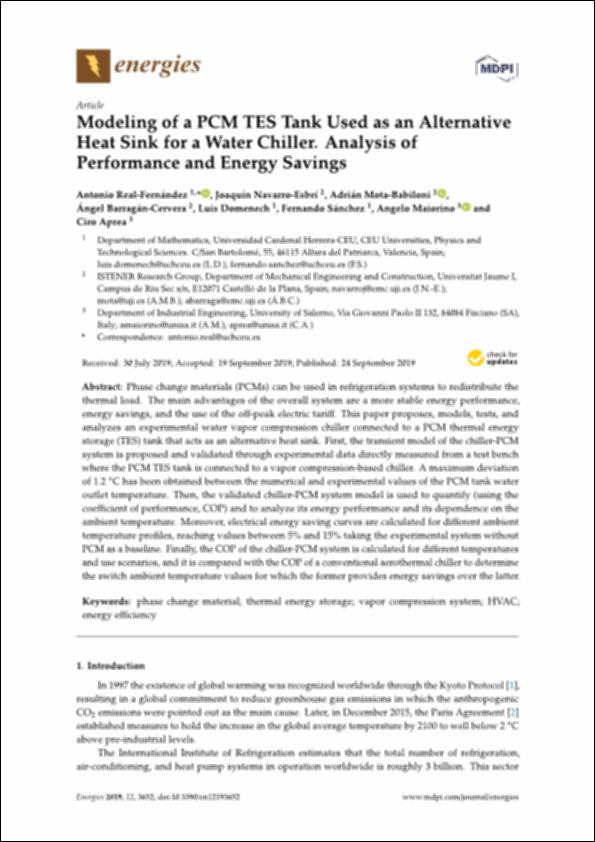Por favor, use este identificador para citar o enlazar este ítem:
http://hdl.handle.net/10637/10777Modeling of a PCM TES tank used as an alternative heat sink for a water chiller : analysis of performance and energy savings
| Título : | Modeling of a PCM TES tank used as an alternative heat sink for a water chiller : analysis of performance and energy savings |
| Autor : | Real Fernández, Antonio Navarro Esbrí, Joaquín Mota Babiloni, Adrián Barragán Cervera, Ángel Doménech Ballester, Luis Sánchez López, Fernando Maiorino, Angelo Aprea, Ciro |
| Materias: | Energy conservation.; Ingeniería mecánica.; Mechanical engineering; Temperature control.; Environmental engineering.; Ahorro energético.; Temperatura - Control.; Ingeniería ambiental. |
| Editorial : | MDPI. |
| Citación : | Real-Fernández, A., Navarro-Esbrí, J., Mota-Baniloni, A, Barragán-Cervera, A., Domenech, L., Sánchez, F. et al. (2019). Modeling of a PCM TES tank used as an alternative heat sink for a water chiller : analysis of performance and energy savings. Energies, vol. 12, n. 19 (24 sep.), art. 3652. DOI: https://doi.org/10.3390/en12193652 |
| Resumen : | Phase change materials (PCMs) can be used in refrigeration systems to redistribute the thermal load. The main advantages of the overall system are a more stable energy performance, energy savings, and the use of the off-peak electric tariff. This paper proposes, models, tests, and analyzes an experimental water vapor compression chiller connected to a PCM thermal energy storage (TES) tank that acts as an alternative heat sink. First, the transient model of the chiller-PCM system is proposed and validated through experimental data directly measured from a test bench where the PCM TES tank is connected to a vapor compression-based chiller. A maximum deviation of 1.2 C has been obtained between the numerical and experimental values of the PCM tank water outlet temperature. Then, the validated chiller-PCM system model is used to quantify (using the coeffcient of performance, COP) and to analyze its energy performance and its dependence on the ambient temperature. Moreover, electrical energy saving curves are calculated for different ambient temperature profiles, reaching values between 5% and 15% taking the experimental system without PCM as a baseline. Finally, the COP of the chiller-PCM system is calculated for di erent temperatures and use scenarios, and it is compared with the COP of a conventional aerothermal chiller to determine the switch ambient temperature values for which the former provides energy savings over the latter. |
| Descripción : | Este artículo se encuentra disponible en la página web de la revista en la siguiente URL: https://www.mdpi.com/1996-1073/12/19/3652 |
| URI : | http://hdl.handle.net/10637/10777 |
| Derechos: | http://creativecommons.org/licenses/by/4.0/deed.es |
| ISSN : | 1996-1073 (Electrónico) |
| Fecha de publicación : | 24-sep-2019 |
| Centro : | Universidad Cardenal Herrera-CEU |
| Aparece en las colecciones: | Dpto. Matemáticas, Física y Ciencias Tecnológicas |
Los ítems de DSpace están protegidos por copyright, con todos los derechos reservados, a menos que se indique lo contrario.


